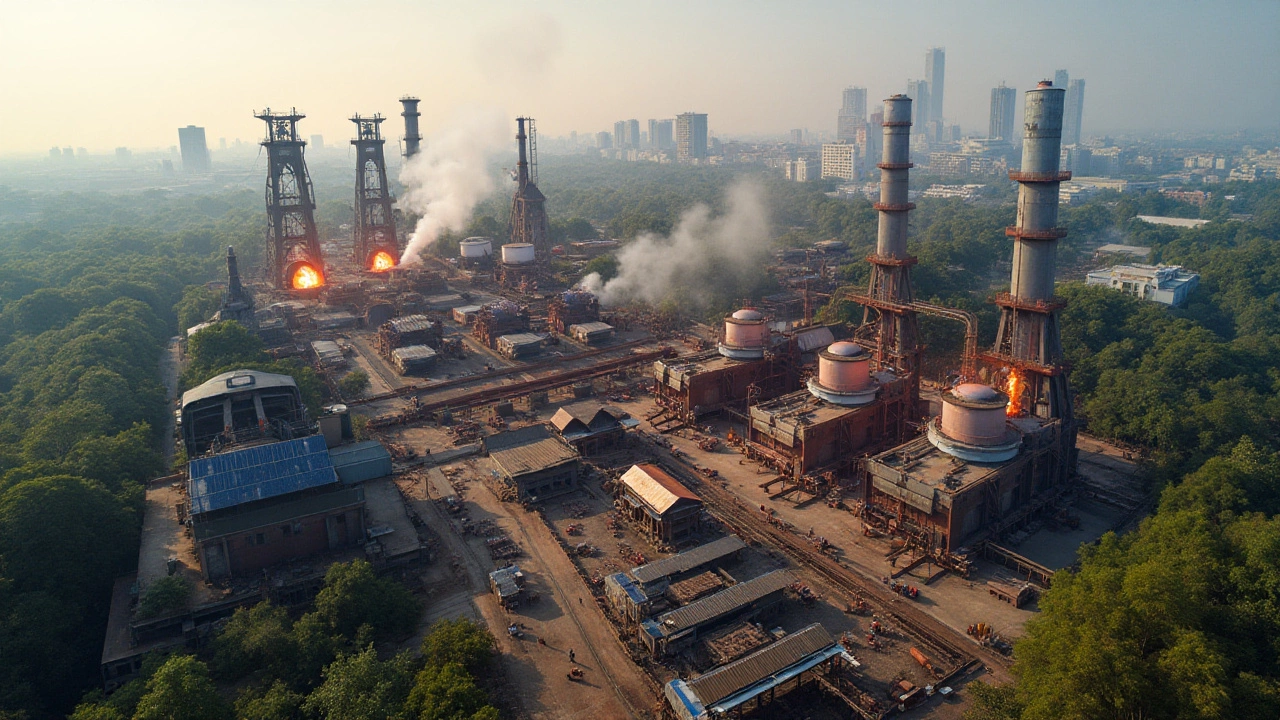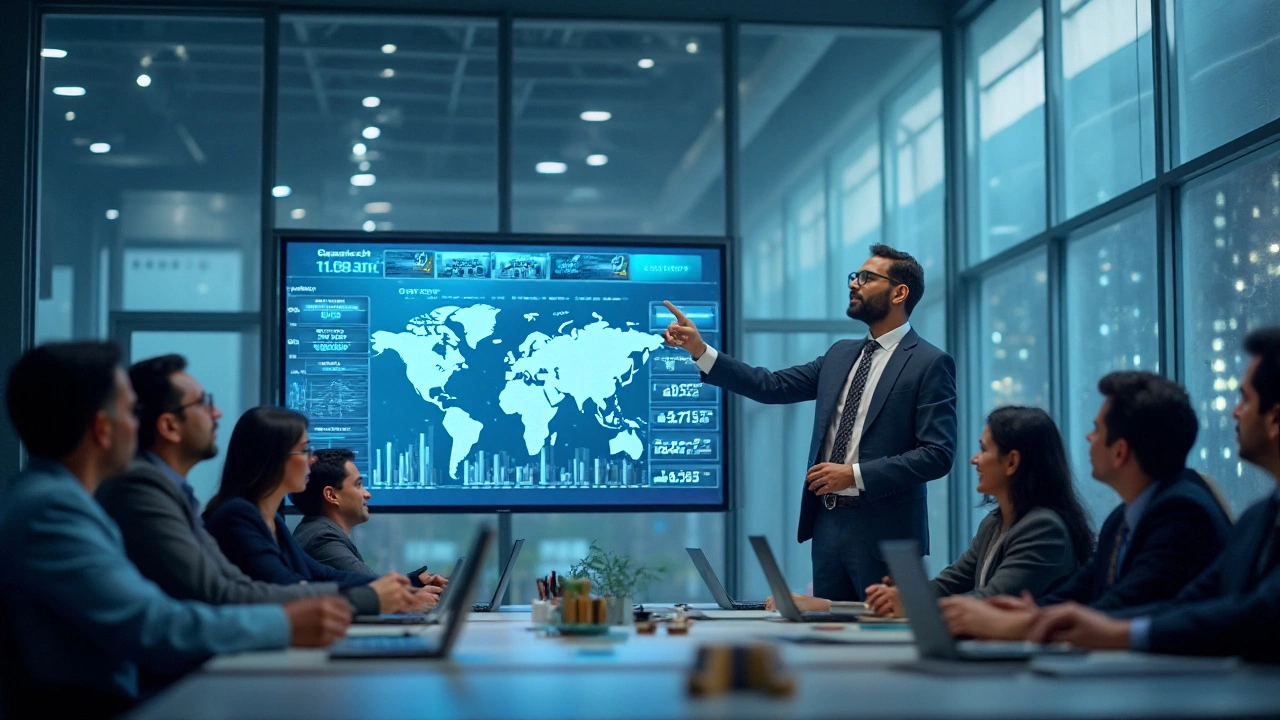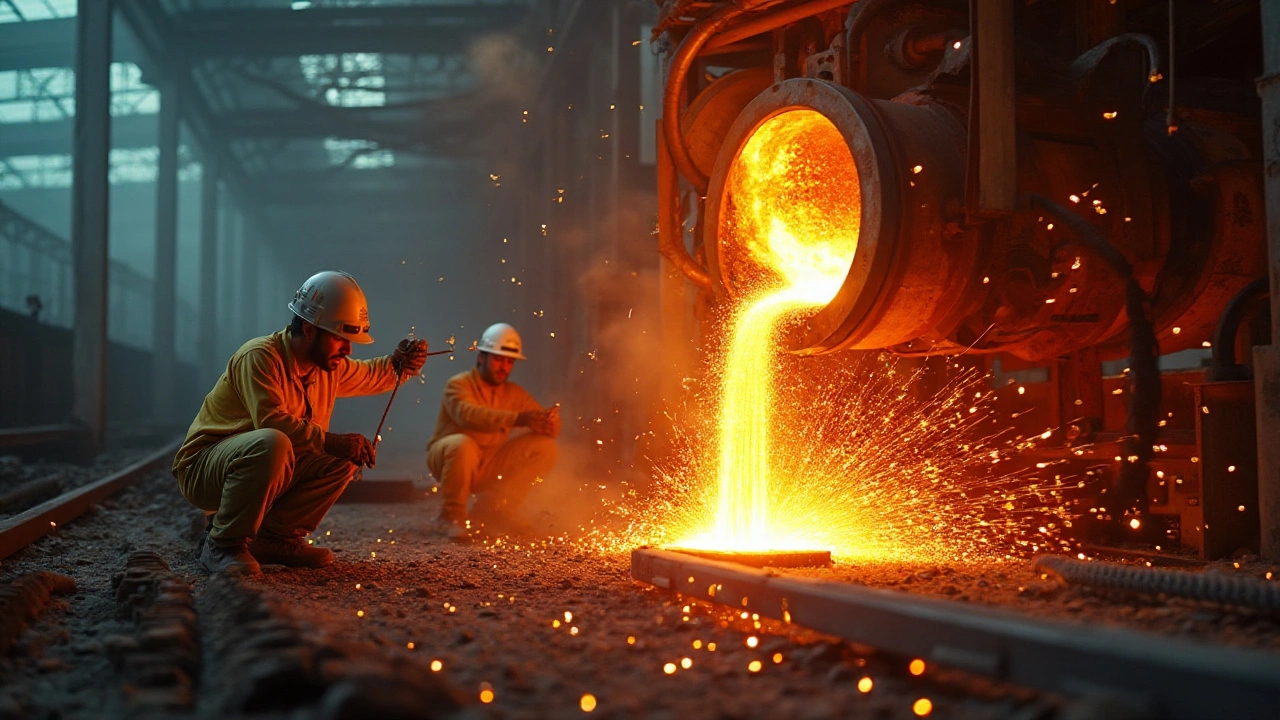Dominant Forces in the Global Steel Industry

The steel industry, a foundational pillar of modern infrastructure, has always been dominated by towering giants whose influence extends beyond mere numbers. Their reach and innovations determine the pulse of global construction, transportation, and technology.
Diving into the realm of steel manufacturers, one encounters fascinating dynamics shaped by a combination of legacy companies and emerging players. Identifying these leaders helps us unravel not only market trends but also how these titans adapt to the growing demands of sustainability and technological advancements.
As the world pivots towards sustainable development, understanding the strategies and contributions of these steel behemoths becomes imperative. Their efforts resonate across economies, touching lives while forging the backbone of future civilizations.
- Historical Giants in the Steel Industry
- Current Leading Steel Manufacturers
- Innovations and Sustainability Efforts
- Global Impact and Economic Influence
- Future Trends in Steel Manufacturing
Historical Giants in the Steel Industry
In the vast landscape of the steel industry, historical giants have long been the bedrock of innovation and production capacity. These early leaders not only pressed the pace of industrialization but defined the path for newer players as they wrote the rules of the game. One cannot tell the saga of steel without mentioning the great Andrew Carnegie, whose influence in the 19th century steel boom was catalytic. At the helm of Carnegie Steel Company, he pioneered large-scale production methods, emphasizing efficiency and cost-cutting strategies that are still revered today. The practices established then set a template for modern steel manufacturing plants. The Ludlum Steel Company, another notable contender in steel's early history, was remarkable for its introduction of alloy steels, diversifying uses beyond what was previously imaginable. Their alloys were the backbone of emerging automotive industries, demonstrating how steel giants were pivotal in revolutionizing other sectors too.
The influence of these early titans was not limited to their industrial conquests. It spanned socioeconomic realms, as they defined labor relations and corporate governance practices. Despite clashes with labor unions—a hallmark of the industrial age—the lessons forged in the heat of these conflicts served to innovate a culture of negotiation and collective bargaining. This enduring legacy underscores the idea that the history of steel is not just about materials and structures; it is a reflection of human progress and ingenuity.
Seen through the lens of cultural significance, who can forget the Tower Bridge in London or the Brooklyn Bridge in New York? Such were the crowning jewels of steel's historical corporations, showcasing not only technological prowess but also embodying the spirit of connectivity. It leads us to wonder: without these daring steel engineers and visionary industrialists, what would our skylines look like? What stories would our urban landscapes tell? Even today, the presence of Carnegie's legacy continues, having morphed into a charitable force impacting education and research through the various trusts and foundations he established. The lore of the steel giants blends seamlessly with both the history and narrative of human development, forever entrenched in the ever-changing society they helped build.
Current Leading Steel Manufacturers
The steel industry today hosts a variety of colossal players, each contributing uniquely to global market demands. The leader of the pack, ArcelorMittal, is more than just a household name; it's a symbol of innovation and resilience in the steel manufacturing world. Born from a merger in 2006, ArcelorMittal boasts production facilities in over 18 countries, casting its influence on every continent. This powerhouse of an organization continuously evolves by integrating advanced technologies to streamline its operations and improve its environmental footprint. The strategies it adopts have set the bar high for other players in the field, nudging the industry towards new frontiers.
Emerging from Asia, China Baowu Steel Group, another major contender, echoes the dynamic spirit of rapid industrialization. With its headquarters in the city of Shanghai, Baowu's ascension highlights the breathtaking pace at which the Chinese steel manufacturing sector has grown. Today, the group is known for driving innovation, emphasizing efficiency, and pushing forward with eco-friendly practices that align with global environmental goals. Baowu Steel's commitment to integrated development and its ambitious expansion plans show a vision that looks not just at corporate profits but long-term sustainability.
The International Energy Agency (IEA) once remarked, "Baowu's commitment to green steel production is a pathfinder for many in the industry, setting a course for a sustainable future."
Meanwhile, in the United States, Nucor Corporation stands as a beacon of strength and adaptability. Known primarily for effective resource management and a decentralized operational structure, Nucor leads the forefront of American steel plants. This flexibility allows it to navigate economic ebbs and flows with remarkable dexterity. The focus on recycled steel production aligns perfectly with the growing worldwide demand for environmentally conscious practices, positioning Nucor as a leader in sustainable innovation and manufacturing.
Another noteworthy titan, Nippon Steel Corporation from Japan, dominates the scene with a sharp focus on advanced technologies and high-quality production. Their philosophy hinges on creating value through steel, exploring new applications that extend well into future technologies. Nippon prides itself on research and development, delving into high-strength and corrosion-resistant products designed for automotive, infrastructure, and advanced electronics sectors.
| Leading Company | Country | Key Focus |
|---|---|---|
| ArcelorMittal | Luxembourg | Innovation, Global Integration |
| China Baowu Steel Group | China | Sustainability, Efficiency |
| Nucor Corporation | USA | Recycled Steel, Decentralization |
| Nippon Steel Corporation | Japan | R&D, High-Quality Production |
Clearly, these leaders in the global steel industry exemplify diverse approaches to growth and sustainability, each forging its path in a landscape undergoing rapid changes. By leveraging unique strategies and aiming for efficiency, they continue shaping the future of steel manufacturing and affirming their positions as trailblazers leading the charge toward a structurally sound and environmentally mindful world.

Innovations and Sustainability Efforts
In the vibrant arena of the steel manufacturing landscape, sustainability and innovation have emerged as pivotal themes, redefining how the industry operates. Amidst growing environmental concerns, the call for reduced emissions and sustainable practices has led giants in the sector to rethink traditional approaches. A blend of novel technologies and creative strategies is steering the industry towards a more sustainable future. Advances in energy efficiency and the use of renewable energy sources are instrumental in this transformation, as companies aim to significantly cut their carbon footprint. Integrating recycled materials into production lines has also become a standard practice, epitomizing the industry's commitment to eco-friendliness.
The dawn of the 21st century marked a notable shift where prominent steel manufacturers began to adopt groundbreaking technologies like electric arc furnaces, which offer a greener alternative to conventional methods. These furnaces substantially reduce greenhouse gas emissions and allow for the use of scrap steel, thus promoting a circular economy. Companies like ArcelorMittal and POSCO have been at the forefront, investing in research and development to find even more efficient ways to process steel, effectively combining innovation with sustainability.
Another significant leap lies in the development of advanced high-strength steels (AHSS). These materials allow for reduced weight without compromising durability, proving indispensable in the automotive and construction sectors. Initiatives in digitalization, utilizing artificial intelligence and automation, are helping manufacturers streamline processes, minimize waste, and enhance overall productivity. By using AI-driven techniques, the industry not only maximizes efficiency but also caters to the burgeoning demand for quick adaptability in product specifications.
"The steel industry is pioneering ways to meet emission targets through technological advancements and innovative approaches," explains a recent report by the World Steel Association, highlighting the sector's ambitious goal towards net-zero emissions by 2050.
Moreover, cross-industry collaborations are fostering innovation, with steel manufacturers partnering with tech firms and environmental organizations to accelerate sustainable advancements. These partnerships are crucial for driving initiatives like CO2 capturing projects and enhancing research into alternative raw materials. It is a vivid example of how the steel industry is leveraging external expertise to fuel change. Initiatives by key players in the industry not only set an example but also demonstrate the seamless integration of sustainability with corporate and environmental responsibility.
Despite these strides, challenges remain. Scaling these innovations globally, especially in developing regions, calls for concerted efforts and substantial investment. However, as the industry adapts to these challenges, the continuous push towards sustainability signals a promising evolution in the realm of steel manufacturing. Such efforts ensure that the steel industry is not just a participant but a leader in the global shift towards a more sustainable industrial era.
| Company | Sustainability Initiative |
|---|---|
| ArcelorMittal | Electric Arc Furnaces & CO2 Reduction Projects |
| POSCO | Research in Advanced High-Strength Steels |
Global Impact and Economic Influence
In the sprawling landscape of the steel industry, the ripples of its influence are felt worldwide, creating a profound economic and global impact. As the backbone of infrastructure, steel manufacturing is pivotal to numerous industries ranging from construction to automotive production. Its reach extends to the rail systems and even the housing sectors, painting a picture of an indispensable resource propelling modern life. The complex web of supply chains ensures that steel reaches all corners of the globe, facilitating economic development and fostering globalization. Countries such as China, India, and the United States play a significant role, engaging in complex trade agreements to meet the insatiable global demand. This not only stabilizes their economies but also aids in job creation, uplifting communities and driving innovation on an international scale.
The strategic position of leading steel manufacturers warrants a closer look at their influence on the global stage. For instance, ArcelorMittal, the largest steel producer globally, has a footprint in more than 60 countries, with its production units spread across Europe, Asia, and the Americas. The company's production strategies and market forecasts can influence prices and availability worldwide. The sheer scale of its operations means that decisions made can have cascading effects on secondary industries reliant on steel goods. An example of this is how shifts in ArcelorMittal's operations can impact automotive manufacturing timelines due to changes in steel supply. The steel industry's substantial contributions to GDP in various countries signify its fundamental role in economic health, dictating economic policies and labor markets.
On a broader economic scale, the international trade of steel is critical. Countries rely on imports and exports of steel products, contributing significantly to balance sheets. An interesting aspect is the role of steel tariffs, often employed as strategic tools by governments to protect domestic industries or as leverage during trade negotiations. These tariffs can alter market dynamics and influence prices on a global level. For instance, the United States' imposition of tariffs under Section 232 had reverberations that impacted global markets, altering trade flows from regular partners to emerging alternatives. Such political maneuvers showcase the dynamic interplay between industry operations and government policies, where the steel industry's health is critical to ensuring long-term economic resilience and prosperity.

Future Trends in Steel Manufacturing
The world of steel manufacturing is experiencing a transformative era where innovations spearhead the drive towards a more sustainable future. As industries around the globe push for greener solutions, steel producers are at the forefront of this revolution. A hallmark of these changes is the increasing integration of recycling technologies, enabling the efficient reuse of scrap steel and reducing dependency on raw iron ore. This move not only minimizes environmental impact but also cuts costs associated with new material sourcing.
One of the key players has stated, "The future is about refining processes to reduce the carbon footprint while enhancing quality and durability," a commitment reflecting the industry's shift towards greener practices. Such innovations are seen in companies adopting electric arc furnaces, which consume significantly less energy and produce fewer emissions compared to traditional methods. This shift is vital in keeping the industry aligned with international climate agreements and local environmental regulations.
Moreover, emerging trends like digitalization and automation play significant roles in reshaping steel plants. With advancements in AI and machine learning, manufacturers can predict equipment failures before they occur, improving maintenance schedules and reducing downtime. Automated systems enhance precision in steel production, leading to fewer defects and wastage, ultimately driving down costs. Such technologies offer a symbiotic relationship between efficiency and sustainability, presenting a win-win scenario for both producers and the planet.
Another exciting trend is the burgeoning field of nanotechnology within the sector. By manipulating materials at the molecular level, steels with unprecedented strength and lightness are being developed, opening doors to applications in industries previously untapped. Aerospace and automotive industries are keenly observing these advancements, as they promise components that could revolutionize weight management and fuel efficiency. Compounded with the growing emphasis on lightweight structures, nanotechnology will likely be integral in the designs of tomorrow.
Here’s a snapshot illustrating the reduction in energy consumption:
| Method | Energy Savings (%) |
|---|---|
| Electric Arc Furnaces | 25-30% |
| Recycling Processes | 30-40% |
The advent of smart materials also plays a significant role in redefining global leaders in the field. These materials adapt to environmental changes, offering capabilities such as self-repair and enhanced heat resistance. Such properties can considerably increase the lifespan and reliability of construction materials, offering an enticing proposition for architects and engineers.
As industries worldwide pivot towards sustainable development, it becomes clear that those who innovate will lead. The future of steel manufacturing hinges on the balance between embracing cutting-edge technology and maintaining environmental stewardship. By capitalizing on these trends, the industry stands poised to redefine the very fabric of modern society, crafting a future where efficiency meets sustainability.